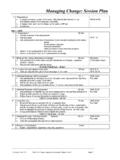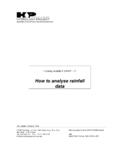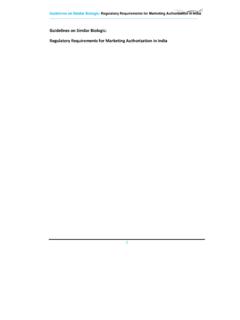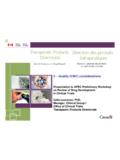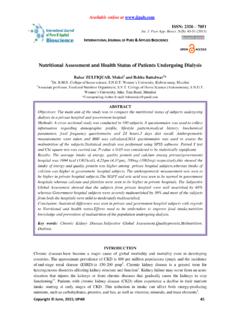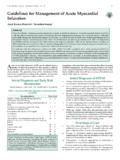Transcription of How to measure biochemical oxygen demand - CWC
1 World Bank & Government of The Netherlands fundedTraining module # WQ - 17 How to measure biochemicaloxygen demandNew Delhi, May 1999 CSMRS Building, 4th Floor, Olof Palme Marg, Hauz Khas,New Delhi 11 00 16 IndiaTel: 68 61 681 / 84 Fax: (+ 91 11) 68 61 685E-Mail: Consultants BV & DELFT HYDRAULICS withHALCROW, TAHAL, CES, ORG & JPSH ydrology Project Training Module File: 17 How to measure Version 05/11/02 Page 1 Table of contentsPage1 Module context22 Module profile33 Session plan44 Overhead/flipchart master55 Evaluation sheets66 Handout137 Additional handout168 Main text18 Hydrology Project Training Module File: 17 How to measure Version 05/11/02 Page 21. Module contextThis module concerns laboratory determination of BOD of water samples. Modules in whichprior training is necessary to complete this module successfully and other available, relatedmodules in this category are listed in the table designing a training course, the relationship between this module and the others, wouldbe maintained by keeping them close together in the syllabus and place them in a logicalsequence.
2 The actual selection of the topics and the depth of training would, of course,depend on the training needs of the participants, their knowledge level and skillsperformance upon the start of the titleCodeObjectives1 How to prepare standardsolutions aWQ - 04 Recognise different types ofglassware Use an analytical balance andmaintain it. Prepare standard solutions2 Understanding the chemistryof dissolved oxygenmeasurementaWQ - 11 Appreciate significance of DOmeasurement Understand the chemistry of DOmeasurement by Winkler method3 How to measure dissolvedoxygen (DO)aWQ - 12 measure dissolved oxygen in watersamples4 Understanding biochemicaloxygen demand testaWQ - 15 Understand the significance andtheory of BOD test5 Understanding dilution andseeding procedures in BODtestaWQ - 16 Understand the need and procedurefor dilution and seeding in BODmeasurement6 Understanding chemicaloxygen demand testWQ - 18 Appreciate significance of CODmeasurement Understand the chemistry of CODmeasurementa prerequisiteHydrology Project Training Module File: 17 How to measure Version 05/11/02 Page 32.
3 Module profileTitle:How to measure biochemical oxygen demandTarget group:HIS function(s): Q1, Q2, Q3, Q5 Duration:Two session, one of 150 min followed by another of 60 min after 3daysObjectives:After the training the participants will be able to: Prepare required dilution measure BOD of water and wastewater samples. Understand need for seedingKey concepts: Estimating required dilution Seeding Method/quality control/reportingTraining methods:Demonstration and laboratory exercisesTraining toolsrequired: Chemicals and glassware required to conduct DO analysis asper SAP Support of a chemistry laboratoryHandouts:As provided in this moduleFurther readingand references: Chemistry for Environmental Engineering, Sawyer, and Parkin. McGraw-Hill, 1994 Standard Methods: for the Examination of Water andWastewater, APHA, AWWA, WEF/1995. APHA PublicationHydrology Project Training Module File: 17 How to measure Version 05/11/02 Page 43.
4 Session planNoActivitiesTimeTools1 Preparations Prepare reagents as listed in the SAP for DO and BODdeterminations Prepare samples as follows: sample A, raw sewage sample B, raw sewage, boiled for 10 min sample C, unpolluted pond or river water sample D, glucose-glutamic acid sample, 150 mg/Leach, alternatively, 300 mg/L glucose solution Prepare enough dilution water for the dilutions of eachsample, as required, taking into account the number ofparticipants2 Introduction Recapitulate the need for dilution and seeding ofsamples Describe preparation of dilution water Glucose-glutamic acid solution for standardisation ofprocedure5 min5 minOHS3 Sources of samples Describe the sources of samples and ask theparticipants to estimate the BOD of each sample Explain that samples B and D would need , ask the participants not to seed sample B tohighlight the need for seeding. Use sample A assource of seed5 min5 minOHS4 Laboratory exercise Ask the participants to read the exercise handout andthe SAP for determination of BOD and DO Divide the participants in groups of two persons each Ask the participants to suggest the dilution for eachsample and calculate the requirement for dilutionwater.
5 Check individually the calculation of each group Demonstrate the use of siphon in filling a BOD bottle Ask the participants to start the exercise; preparedilutions, fill bottles, find initial DO for each dilution andincubate the samples10 min20 min100 minHandoutand OHS5 Conclusion Ask the group to find the final DO after 3 dayincubation period and write report Discuss results60 minBoardHydrology Project Training Module File: 17 How to measure Version 05/11/02 Page 54. Overhead/flipchart masterOHS format guidelinesType of textStyleSettingHeadings:OHS-TitleArial 30-36, with bottom border line (not:underline)Text:OHS-lev1 OHS-lev2 Arial 24-26, maximum two levelsCase:Sentence case. Avoid full text in :Use occasionally and in a consistent wayListings:OHS-lev1 OHS-lev1-NumberedBig for definite series of steps. Avoidroman numbers and :None, as these get lost in photocopying andsome colours do not reproduce at OHS-EquationUse of a table will ease horizontal alignmentover more lines (columns)Use equation editor for advanced formattingonlyHydrology Project Training Module File: 17 How to measure Version 05/11/02 Page 6 BOD measurement procedure Dilution Seeding Standard sample to check procedureHydrology Project Training Module File: 17 How to measure Version 05/11/02 Page 7 Characteristics of samplesSample SourceEstimatedBOD, mg/LSeedDilutionARaw sewage100 200 Present2 %BRaw sewage,boiled100 200 Absent2 %CRiver water2 5 Presentnot requiredDGlucose std200 Project Training Module File.
6 17 How to measure Version 05/11/02 Page 8 Dilution & seeding Dilution water is saturated with DO at 270C Dilution water contains inorganic salts Prepare 1000 mL of diluted samples A, B & D Use A as source of seed for D, 3 mL/1000 mL Use siphon to fill three bottles for each sample Ensure that sample C has sufficient DOHydrology Project Training Module File: 17 How to measure Version 05/11/02 Page 9 Determine DO & BOD Initially, 1 bottle each sample After incubation, 2 bottles each sample Calculate BODH ydrology Project Training Module File: 17 How to measure Version 05/11/02 Page 10 Report Compare BOD of raw & boiled sewage Comment on quality of river water Was your technique acceptableHydrology Project Training Module File: 17 How to measure Version 05/11/02 Page 115. Evaluation sheetsHydrology Project Training Module File: 17 How to measure Version 05/11/02 Page 12 Hydrology Project Training Module File: 17 How to measure Version 05/11/02 Page 136.
7 HandoutHydrology Project Training Module File: 17 How to measure Version 05/11/02 Page 14 BOD measurement procedure Dilution Seeding Standard sample to check procedureCharacteristics of samplesSampleSourceEstimated BOD, mg/L SeedDilutionARaw sewage100 200 Present2 %BRaw sewage, boiled100 200 Absent2 %CRiver water2 5 Presentnot requiredDGlucose std200 & seeding Dilution water is saturated with DO at 270C Dilution water contains inorganic salts Prepare 1000 mL of diluted samples A, B & D Use A as source of seed for D, 3 mL/1000 mL Use siphon to fill three bottles for each sample Ensure that sample C has sufficient DODetermine DO & BOD Initially, 1 bottle each sample After incubation, 2 bottles each sample Calculate BODR eport Compare BOD of raw & boiled sewage Comment on quality of river water Was your technique acceptableHydrology Project Training Module File: 17 How to measure Version 05/11/02 Page 15 Add copy of Main text in chapter 8, for all Project Training Module File: 17 How to measure Version 05/11/02 Page 167.
8 Additional handoutThese handouts are distributed during delivery and contain test questions, answers toquestions, special worksheets, optional information, and other matters you would not like tobe seen in the regular is a good practice to pre-punch these additional handouts, so the participants can easilyinsert them in the main handout Project Training Module File: 17 How to measure Version 05/11/02 Page 17 Hydrology Project Training Module File: 17 How to measure Version 05/11/02 Page 188. Main & for BOD 2 SAP for DO5 Hydrology Project Training Module File: 17 How to measure Version 05/11/02 Page 1 How to measure biochemical oxygen demand1. Aima. To determine the biochemical oxygen demand (BOD) of various samples of waterb. To understand the need for seeding in the BOD testc. To check the procedure by determining the BOD value of a standard glucose-glutamicacid sample2. Methoda.
9 Collect samples marked A, B, C and D. The instructor will tell you the volume of eachsample you Prepare the BOD bottles for analysis in accordance with the Standard AnalyticalProcedure for BOD. Prepare only ONE dilution as explained by the instructor for Using standardised sodium thiosulphate titrant, determine the DO in one bottle of eachsample according to the Standard Analytical Procedure for DO measurement. Incubatethe other two bottles at 27oC and determine the DO after 3 You will be told the origin of the samples that you have begun to analyse. Based on thisinformation and your knowledge of water quality and the BOD test, fill in a table similar tothe one below to predict the BOD results which you expect and the reason for yourprediction:SampleSource of SamplePredictedBOD3 Reason for your BOD3 predictionABCD3. Observations & calculationsNOTE: In order to calculate values for the table below you will need to refer to the StandardAnalytical Procedures for both DO and , mg/LbeforeincubationDO, mg/LafterincubationBOD, mg/Lof sampleABCD4.
10 ReportWhen writing your report the following aspects should be addressed: the aim of the investigation the results that you have produced, acceptability of your technique whether the results were as you originally predicted and, if they were not, thereasons why they deviated river water qualityHydrology Project Training Module File: 17 How to measure Version 05/11/02 Page 2 Hydrology Project Training Module File: 17 How to measure Version 05/11/02 Page 3 Hydrology Project Training Module File: 17 How to measure Version 05/11/02 Page 4 Hydrology Project Training Module File: 17 How to measure Version 05/11/02 Page 5 Hydrology Project Training Module File: 17 How to measure Version 05/11/02 Page 6


